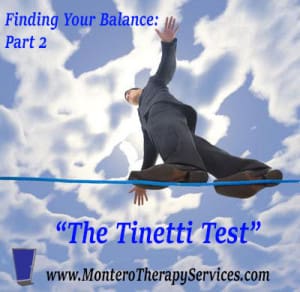Welcome to Part 2 of our “Finding Your Balance” Blog Series.
Just in case you missed our previous Blog, Part 1: The Functional Reach Test, it can be found by clicking here.
Our goal with this Blog Series is to provide you with a series of clinically relevent objective tests and measures that you can use in your setting. For each of the tests reviewed here, we will give you:
- The “how to”
- The “pros and cons”
- The statistical measures
- The “norms” for the geriatric population
- A ready-to-use printout of a customized test form that you can use in your setting immediately
This objective data should be included in your clinical documentation and will support the necessity of your services and help support your goals and treatment plan. Not only that, but you will gain valuable insight into the specific limitations of your residents and be able to develop a natural progressive treatment plan to keep them on their feet! If you use an EMR, no worries, you can reference the test score in your electronic documentation and keep the paper copy in your soft chart. Remember, Medicare is looking for objective clinical data– so why not give it to them!!
Measuring Balance
When selecting a test to measure balance, there are multiple factors therapists consider, which ultimately help match up a test to our resident.
- How practical is the test?
- Is the test easy to administer?
- Can the test be incorporated into a treatment session?
- Is it cost effective?
- Is equipment required?
- Statistically is it a “good” test — is it reliable, valid, reproducible?
For our geriatric residents, there are also multiple additional considerations including: cognition, medications and interactions, sensory impairments, endurance and the severity of the balance impairment we are attempting to measure… just to name a few.
The Tinetti Test – A.K.A. “Performance-Oriented Mobility Assessment (POMA)
What Does It Measure?: Has 9 Balance Components that measure balance in sitting, standing and moving; Has 7 Gait Components that measure deviations and quality. The total score is used to measure gait, balance and fall risk in older adults. Measures vestibular and non-vestibular balance.
How Long Does It Take?: Less than 15 minutes
Equipment Needed?: Firm armless chair; Stopwatch; 15 feet of walking space;
How To: (See download below for step-by-step test instructions)
Balance Component (POMA-B)
- Observe sitting balance in chair
- Observe balance on sit to stand
- Standing with feet together, press lightly on sternum 3x and observe balance
- Feet together, eyes closed, observe balance
- Eyes open, turn 360 degrees and sit, observe quality
Gait Component:(POMA-G)
- Sit to stand and walk 15′ at usual pace
- Turn and walk back at “rapid but safe” pace
- Observe path taken and quality
Norms:
- Norms vary with age and disease process
- Normal value for ages 65-79: 25-27
- Normal value for ages > 80 decrease: 17-23
Results:
- < = 18 : High Fall Risk
- 19-23 : Moderate Fall Risk
- > = 24 : Low Fall Risk
Pros: Quick, little equipment and space needed, can use with or without assistive device, valid and reliable measure of balance and fall risk
Cons: Score on test impacted by cognitive impairment, better negative predictor of falling than positive
Print Out of Test and Documentation Form from the Toolbox
Documentation and Billing
The initial performance of the test can be incorporated into an initial evaluation or performed separately at any time during the course of treatment. If the test is performed on the initial evaluation, the score can be documented and used to establish short and long term goals for balance improvement, or “fall risk reduction.” Subsequent repeat performances of the test can be done during a treatment session and the time can be allocated to CPT 97112, neuro muscular re-education, a time-based code incorporating therapeutic procedures to improve balance, coordination, kinesthetic sense, posture, and proprioception. If you choose to use balance as a measure for your Functional Limitation Reporting, the G-Code Category “Changing and Maintaining Body Position” is appropriate, with G8981 for the Current Status, G8982 for the Goal Status and G8983 for the Discharge Status.
Treatment sessions can include portions of the test incorporated into treatment activities such as: standing feet together, eyes open, eyes closed, nudging sternum, sit-stand with walking and turning, etc.
In Summary
Residents like to see evidence that they are progressing, and even though they may not have progressed to the next “level” of independence, the Tinetti Test allows them to see that they are performing tasks with less loss of balance, and that provides positive reinforcement to continue to progress toward goals. The Tinetti is an easy test to perform anywhere, anytime.
Whether you are screening residents for fall risk or providing treatment to residents with balance deficits, if you have not been using objective tests and measures for balance, the Tinetti or POMA is a great place to start!
Now Test-Away!
Any questions, Just Ask! by visiting our Q&A forum.
In Your Corner,
Dolores
*A special thank you to physical therapist extraordinaire, Laura Minnick, for contributions to this post.
